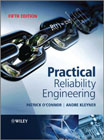
This book provides a comprehensive, up-to-date coverage of fundamental concepts, models, methods and practices of modern reliability engineering. It is intended for a variety of readers ranging from college students to seasoned engineering professionals involved in design, development, manufacture and maintenance of reliable engineering products and systems. The books emphasis is on practical aspects of engineering, with a balanced mixture of reliability theory and applications. The topics covered include the mathematics of reliability, physics of failure, graphical and software methods of failure data analysis, reliability prediction and modelling, design for reliability and safety, accelerated testing, management and economics of reliability programmes. Reliability and safety aspects of mechanical, electronic and software engineering are alsodescribed. Practical Reliability Engineering covers the requirements of the Certified Reliability Engineer curriculum of the American Society for Quality. Each chapter is supported by practice questions, and a solutions manual is available to course tutors. Since its first best-selling edition, this book has been recognized as a primary source with a worldwide reputation and it has beenprogressively updated in the following editions. For the fifth edition the original author, Patrick OConnor, has been joined by Andre Kleyner, a reliability practitioner with extensive industrial and academic experience. The new edition adds: Software applications of statistical methods, including probability plotting and a wider use of common software tools such as Microsoft Excel. Expanded description and applications of Monte Carlo simulation methods, in a newchapter. More detailed descriptions of reliability prediction methods. Expanded treatment of accelerated test data analysis. Warranty data analysis. Expanded description of reliability demonstration methods, in a new chapter. Revisedand expanded practice questions at the end of each chapter. INDICE: Preface to the First Edition. Preface to the Second Edition. Preface to the Third Edition. Preface to Third Edition Revised. Preface to Fourth Edition. Preface to Fifth Edition. Acknowledgements. Notation and Definitions. 1 Introduction to Reliability Engineering. What is Reliability Engineering? Why Teach Reliability Engineering? Why do Engineering Products Fail? Probabilistic Reliability. Repairable and Non-repairable Items. The Pattern of Failures with Time (Non-repairable Items). The Pattern of Failures with Time (RepairableItems). The Development of Reliability Engineering. Courses, Conferences and Literature. Organizations Involved in Reliability Work. Reliability as an Effectiveness Parameter. Reliability Programme Activities. Reliability Economics and Management. 2 Reliability Mathematics. Introduction. Variation. ProbabilityConcepts. Rules of Probability. Continuous Variation. Continuous DistributionFunctions. Summary of Continuous Statistical Distributions. Variation in Engineering. Conclusions. Discrete variation. Statistical Confidence. Statistical Hypothesis Testing. Non-parametric Inferential Methods. Goodness of Fit. Series of Events (Point Processes). Computer Software for Statistics. Practical Conclusions. 3 Life Data Analysis and Probability Plotting. Introduction. Life Data Classification. Ranking of Data. Weibull Distribution. Computerized Data Analysis and Probability Plotting. Confidence Bounds for Life Data Analysis. Choosing the Best Distribution and Assessing the Results. 4 Monte Carlo Simulation. Introduction. Monte Carlo Simulation Basics. Additional Statistical Distributions. Sampling a Statistical Distribution. Basic Steps for Performing a Monte Carlo Simulation. Monte Carlo Method Summary. 5 Loadstrength Interference. Introduction. Distributed Load and Strength. Analysis of Loadstrength Interference. Effect of Safety Margin and Loading Roughness on Reliability (Multiple Load Applications). Practical Aspects. 6 Reliability Prediction and Modelling. Introduction. Fundamental Limitations of Reliability Prediction. Standards Based Reliability Prediction Other Methods for Reliability Predictions. Practical Aspects. Systems Reliability Models. Availability of Repairable Systems. Modular Design. Block Diagram Analysis. Fault Tree Analysis (FTA). State-space Analysis (Markov Analysis). Petri Nets. Reliability Apportionment. 7 Design for Reliability. Introduction. Design for reliability Process. Identify. Design. Analyse. Verify. Validate. Control. Assessing the DfR Capability of an Organization. 8 Reliability of Mechanical Components and Systems. Introduction. Mechanical Stress, Strength and Fracture. Fatigue. Creep. Wear. Corrosion. Vibration and Shock. Temperature Effects. Materials. Components. Processes. 9 Electronic Systems Reliability. Introduction. Reliability of Electronic Components. Component Types and Failure Mechanisms. Summary of Device Failure Modes. Circuit and System Aspects. Electronic System Reliabili
- ISBN: 978-0-470-97982-2
- Editorial: John Wiley & Sons
- Encuadernacion: Cartoné
- Páginas: 512
- Fecha Publicación: 16/12/2011
- Nº Volúmenes: 1
- Idioma: Inglés
